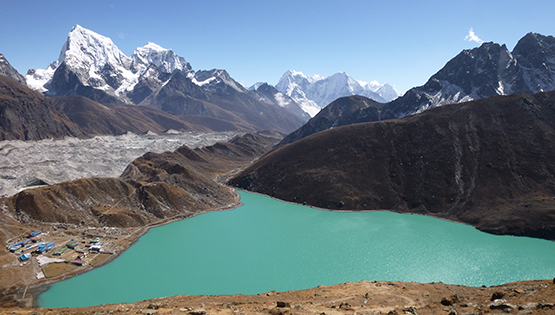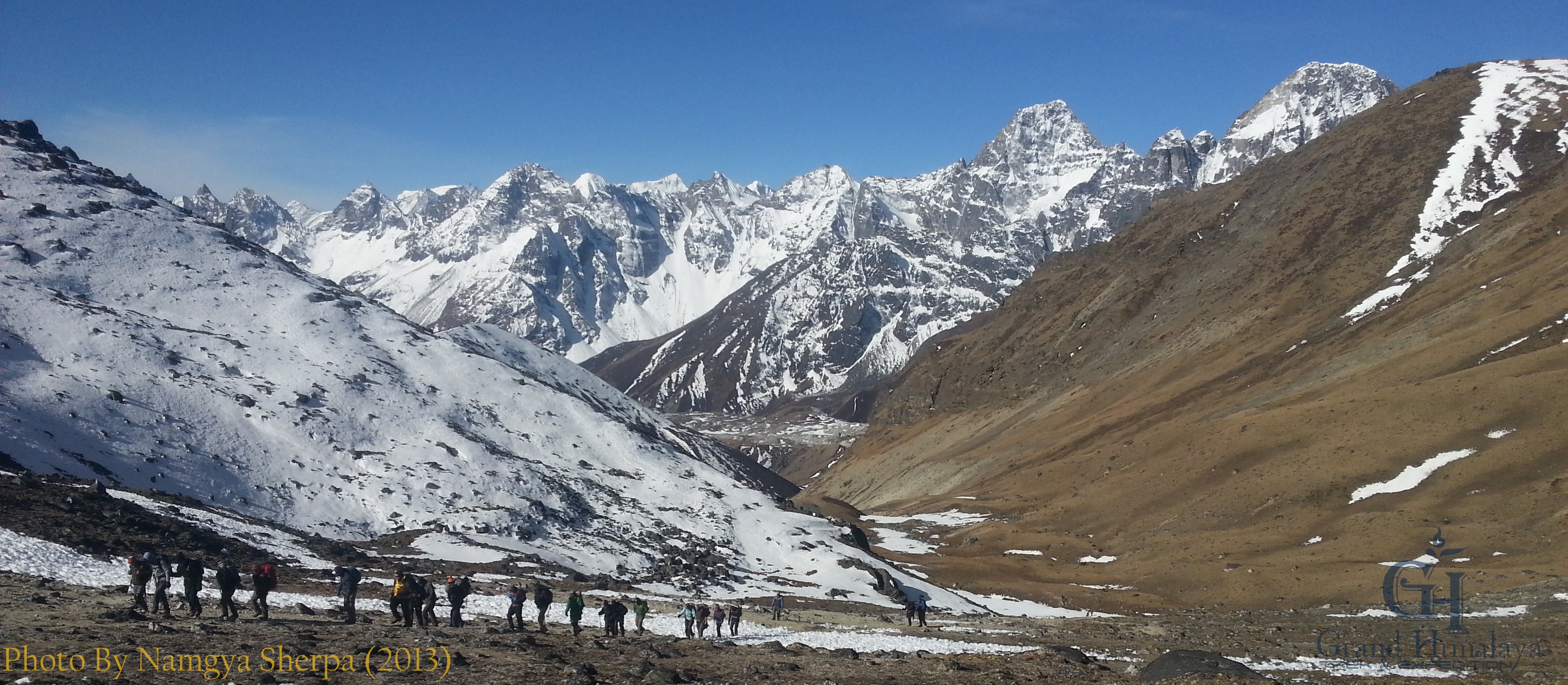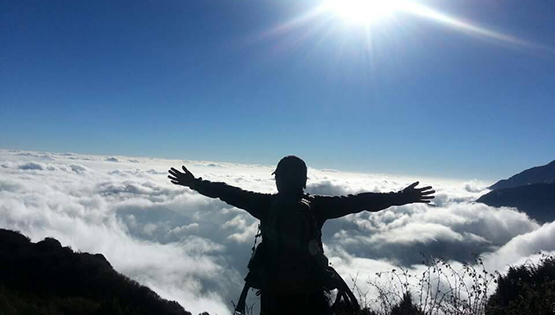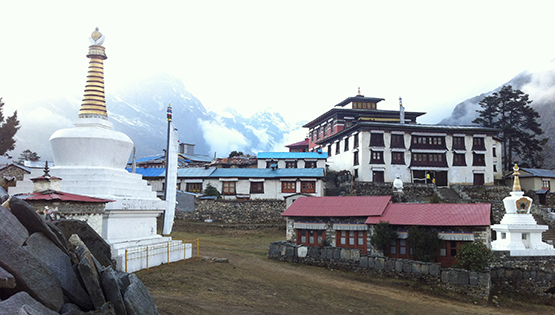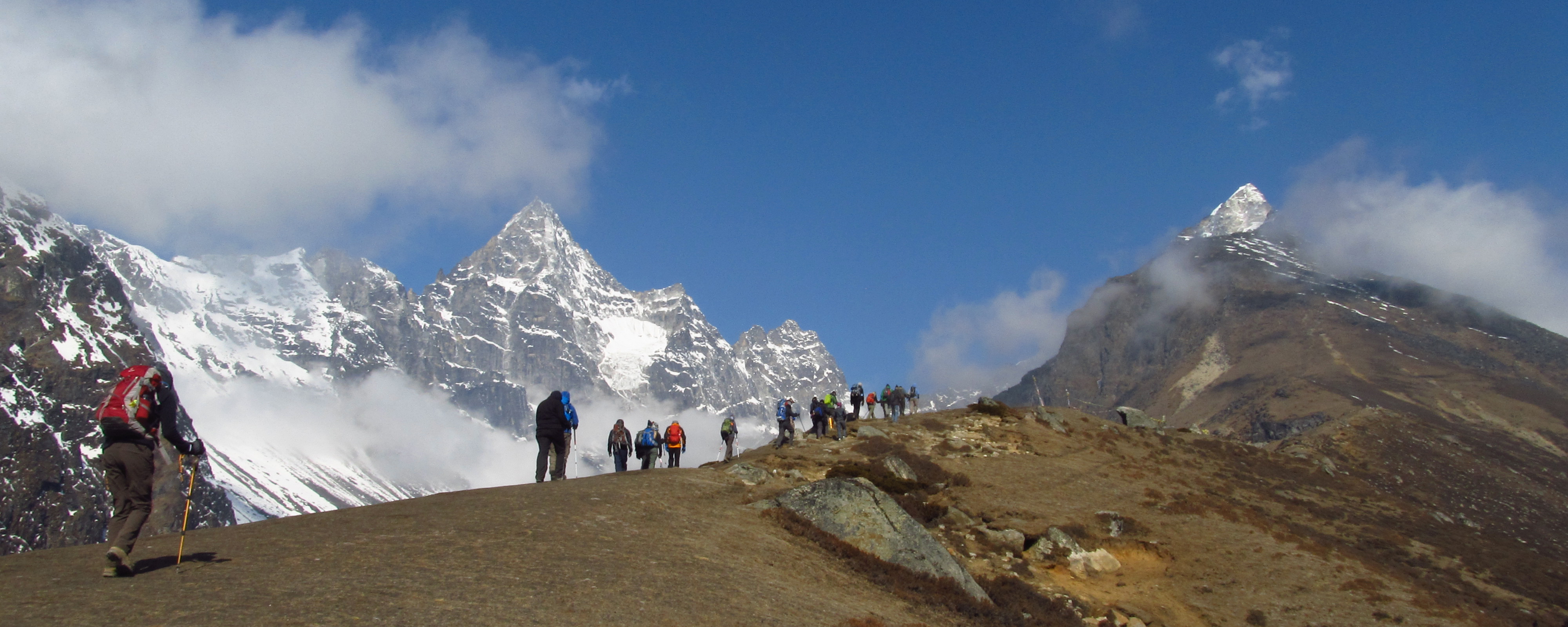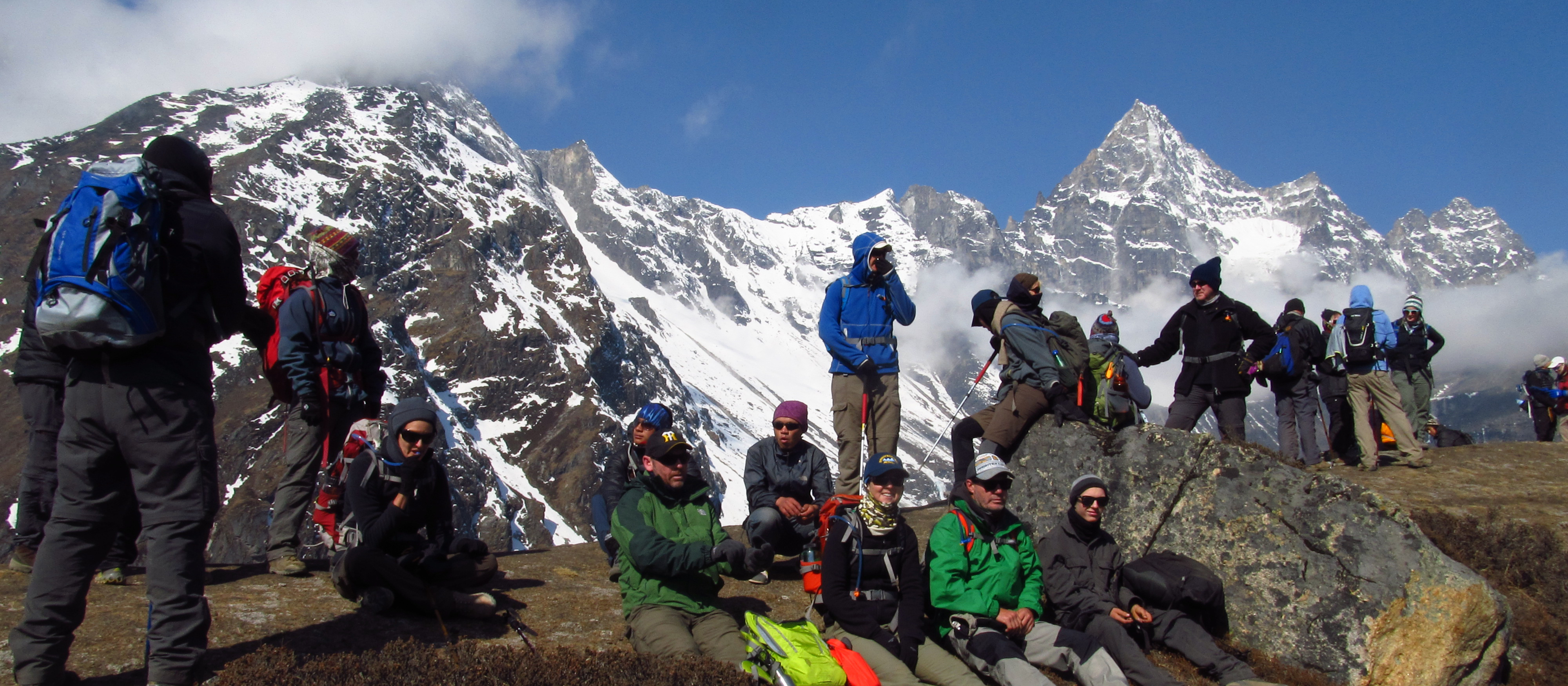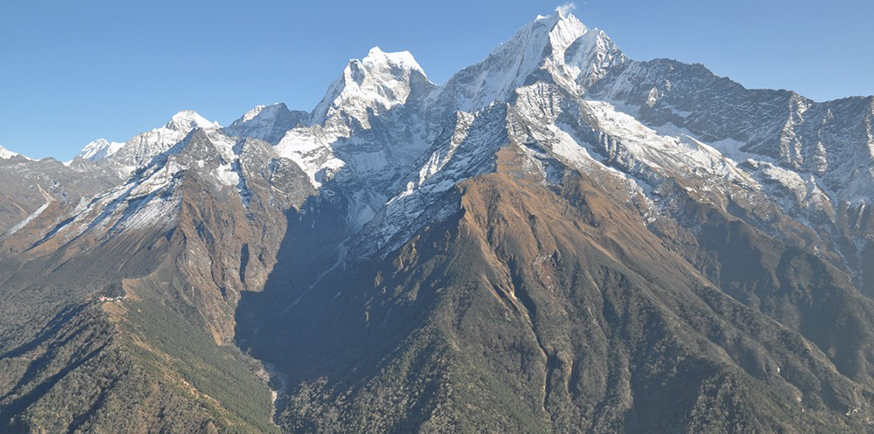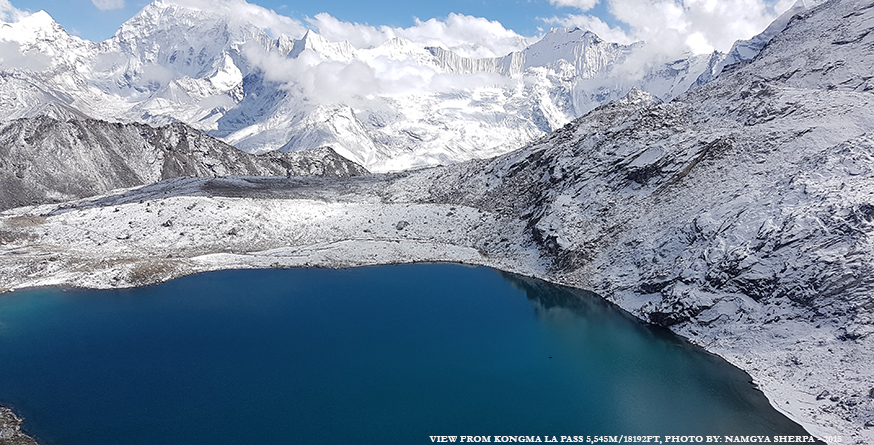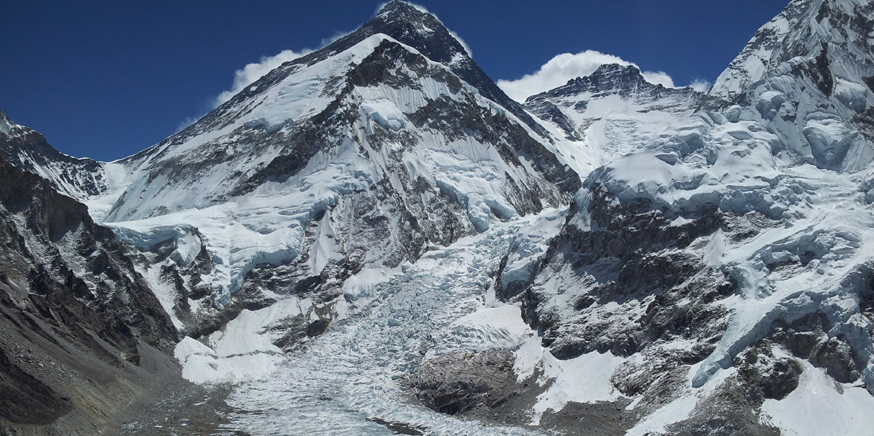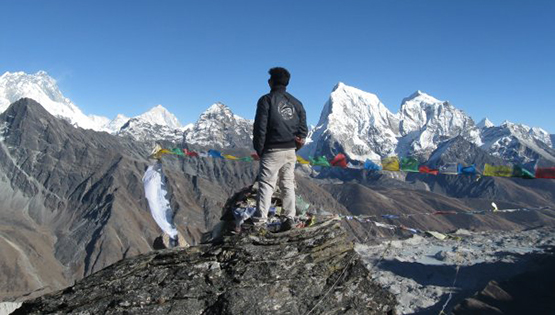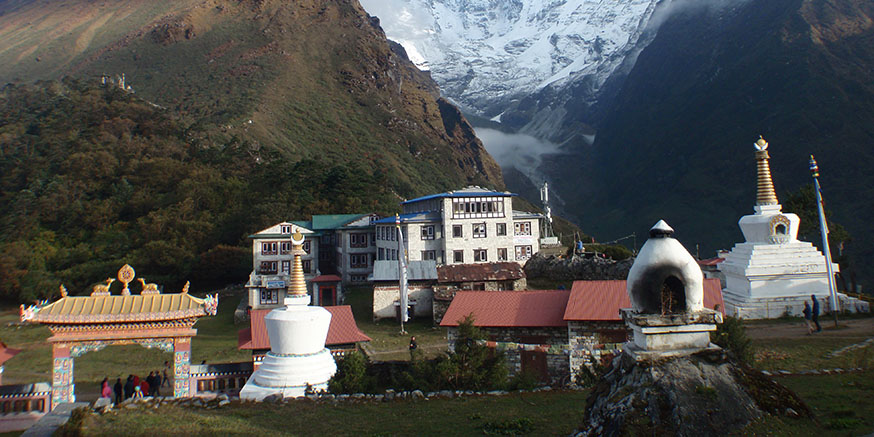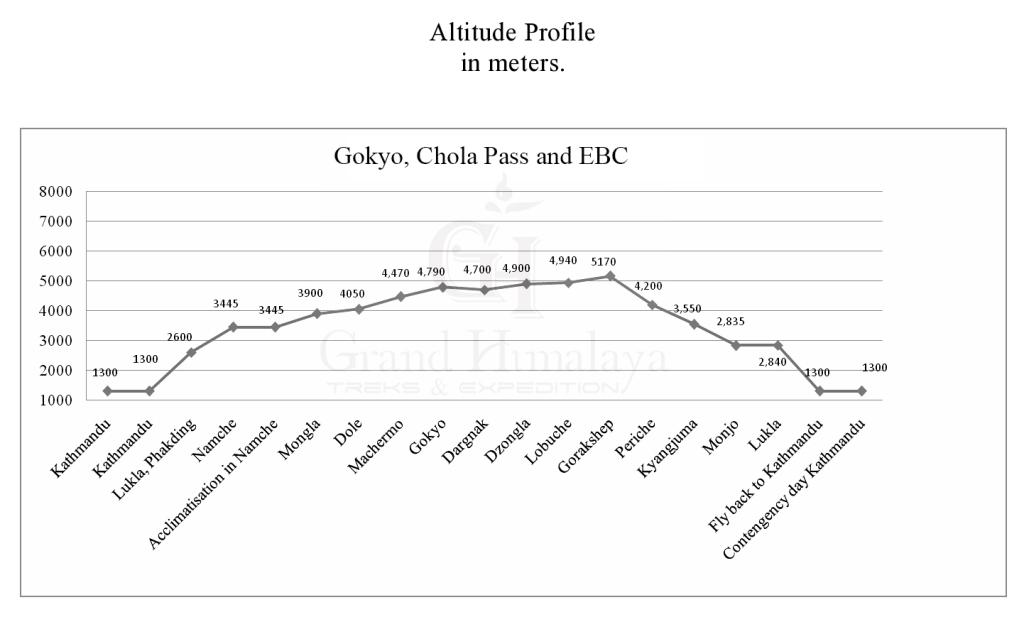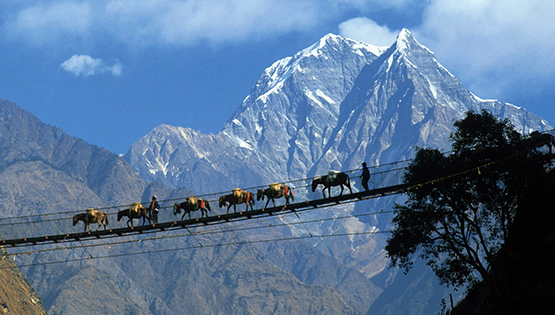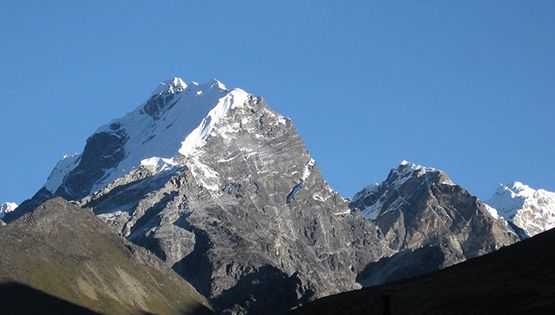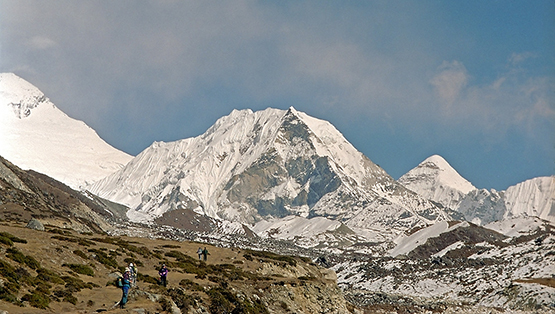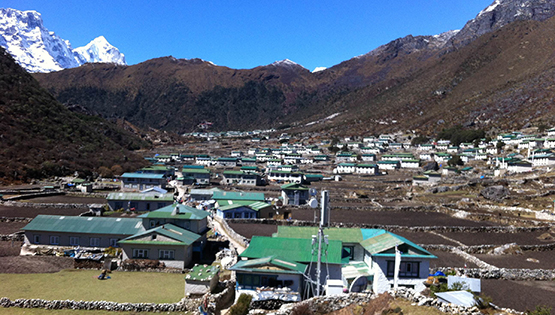The Gokyo Lakes region at the head of the Dudh Kosi Valley provides a great alternative to the popular Everest Base Camp trek. It is a more tranquil trek through the Sherpa heartland that affords ample time for acclimatization with opportunities to savor the mountain panoramas from beautiful alpine campsites. The highlights of the trek are our ascent of Gokyo Ri. From the summit we gain superb views of Everest as well as the 8000m peaks of Lhotse, Makalu and Cho-Oyu. And crossing chola pass glacier (5,380m) is a real fun adventure which gives you an opportunity to set your foot at the highest point of your life. Gokyo Tso (Lake), also called Dudh Pokhari, is the main lake with an area of 42.9 ha (106 acres), and the village of Gokyo lies on its eastern shore. Gokyo Lake in Nepal's Sagarmatha National Park, located at an altitude of 4,700m (15,400ft) above sea level. Unique among natural heritage sites world-wide is the Sagarmatha National Park, which includes Mt. Everest (8,848 m) and other high peaks such as Lhotse, Lhotse Shar, Cho-Oyu, Ama Dablam, Pumori, Kangtega, Gyachung Kang, Thamserku, Kwangde, and many more. Located North-east of Kathmandu, Sagarmatha National Park is 1,148 sq km in area and consists of the upper catchment areas of the Dudh Koshi, Bhote Koshi and the Imja Khola (rivers). Much of the park lies above 3,000m. Sagarmatha is rugged with deep gorges, glaciers and nonnegotiable ice and rock faces. Locally known as the 'Khumbu', it is the home of the famous Sherpa people.
The Sherpas make a living by farming barley and potatoes, and graze their yaks in high altitude pastures. Young Sherpas have also made their name in mountaineering and the trekking industry has of late become the community's economic mainstay. In 1979 the park was declared a World Heritage Site.
Famous for its spectacular mountain peaks and the loyalty and friendliness of its inhabitants (the Sherpas), the Everest region (Khumbu) is one of the most popular destinations for tourists in Nepal.
While trekking is possible in this area the whole year round, the best times to visit are from the beginning of March to mid May and from the beginning of September to mid November. The winters are very cold and snow may make it difficult to travel higher than Tengboche, and also lodges may be closed above this altitude. Summers, on the other hand, are wet, and the spectacular peaks are often lost in the clouds. April and early May is a good time to see the hedgerows and trees bursting into bloom, with Rhododendrons, in particular, adding a spectacular splash of colour to the landscape. However, dust from the plains of India during the spring routinely provides less than ideal conditions for clear mountain views. The views are much better after the summer monsoons have cleared the atmosphere of dust, but the days are shorter and cooler.
Wildlife most likely to be seen in Sagarmatha is the Himalaya Tahr, Ghoral, Musk deer, Pikka (mouse hare) weasel and occasionally jackal. Other rarely seen animals are Himalayan black bear, wolf, lynx and snow leopard. Birds commonly seen are Impeyan pheasant, blood pheasant, snow cock, snow pigeon, red billed and yellow billed chough, Himalayan griffin vulture and lammergeyers. Sagarmatha National Park is also known as Khumbu region and sometimes, Everest region.
A very warm welcome to the Kingdom of Himalayas. Upon your arrival at the Tribhuvan international airport our representative welcomes you and assists you transfer in your hotel in Kathmandu. After time to get refreshed, evening you'll meet and transfer for welcome dinner in one of the typical Nepalese restaurant in the heart of Kathmandu i.e. Utsav or Nepali Chula (Kitchen). Here you will not simply experience the traditional Nepalese dish but will be entertained with Nepalese traditional dance and folk songs. After the dinner, you will be transferred back to your respective hotel.
Kathmandu is the historical and cultural heart of Nepal and has been a popular destination for tourists ever since Nepal opened its doors to visitors. The city presents a wonderful mix of Hinduism, Tibetan Buddhism and Western influence in the Valley. Bauddhanath: Stupa with its 130 ft. dome. One of the world largest Stupa, Bouddha is generally acknowledged to be the most important Tibetan Buddhist monument outside Tibet. Tibetans simply call it CHORTEN CHEMPO "Great Stupa". It has now become the Mecca of Tibetan exiles in Nepal. Walking around Bouddhnath one often fins men wearing long braids wrapped around their heads. Many of these pilgrims carry their own prayer wheels, which they spin incessantly. Pupshupatinath Temple: Pashupatinath is considered one of the holiest shrines of all the Hindu temples. The temple has remained the presiding deity of ruling Nepalese Royalty. Located on the banks of the Bagmati river, this two-tiered magnificent golden temple with four triple silver doorways is unique example of the Nepalese temple architecture. It is one of the largest Hindu temple complex in' South Asia with hundreds of Shiva lingams, shrines icons of various Hindu god and goddess insides. This temple site occupies an area of 281 hectors in total. The main entrance of this temple is in the western side facing a small street of Deopatan market. As non-Hindus are not allowed to enter this temple courtyard. They are advised to go on the other side of the river in the East to have a glimpse of the temple complex. In the middle of the spring (Feb. March) every year there occurs a festival called Shivaratri. The world Shivaratri means the holy night of Lord Shiva. On this day many devotees visit the Pashupati Nath temple and make the ceremonial fire. Most of the devotees spend the night offering prayers to Shiva. This festival attracts tens of thousands of pilgrims from India besides the locals. Historically pre-Christian era this temple seems to have its origin away back to the early Kirat period. Stone sculptures found in the vicinity support the antiquity of this place. This holy site is 6 km. east oil down town Kathmandu. Regular bus and taxi services are easily available from a city points. After the city tour, our guide or the company manager will do the full briefing of the trek. They will also take the opportunity to check the members' personal equipment as the city bazaars and climbing shops will provide the last chance to correct any deficiencies.
It's a 30 minutes of panoramic thrill flying into Lukla in a Twin Otter plane. On a clear day, the views of snow-capped mountain peaks sprawling around you outside your plane are almost ecstatic, beginning a whole chain of memorable experiences that stay with you for a long, long time. This is an exciting flight, which should give a glimpse of Everest in the distance. In Lukla, we will meet our trek staffs and porters and set off straightaway for our first night's stop at Phakding 2610m. Situated on the banks of the Dudh Kosi, which drains the whole of the Khumbu Region, this small hamlet is on the main trade route through the area and there are a number of clean, well-built lodges where we can spend the night. After the city tour, our guide or the company manager will do the full briefing of the trek. They will also take the opportunity to check the members' personal equipment as the city bazaars and climbing shops will provide the last chance to correct any deficiencies.
We will continue up the banks of the Dudh Kosi, crossing it twice by small suspension bridges before reaching the Khumbu National Park. We will then cross the confluence of the Dudh Kosi and the Bhote Kosi on a high suspension bridge and climb steeply for about two hours up 'Namche Hill' to reach Namche Bazaar (3,440m/11,286ft). This is a prosperous trading town and the capital of the Khumbu Region. Many Tibetans cross the nearby border to trade their wares and the local market is a fascinating spectacle. This is a good place to buy genuine Tibetan artefacts. Just across the valley to the east stand the peaks of Thamserku 6623m and Kangtega 6782m, both very impressive mountains.
Namche Bazzar is the highlight of EBC trek and the heart of the Everest (Khumbu) region which has government offices, ATMs, Internet cafes, shops, restaurants, a bakery and a colourful market each Friday evening and Saturday. This is first scheduled 'acclimatization' day for this trek. Health experts always recommend us to stay active and moving during the rest day too instead of being idle. If we trek few hundred meters vertical during the day, it will help us to acclimatize with the alien heights that we are going to confront on the trek. Having been born, leading and organizing trips in the Himalayas, we believe in the natural process of acclimatization... "Climb high, sleep low". We take an interesting side trip up to Khumjung and climb up to famous airstrip at Syangboche. Just above the airstrip is the Everest View Hotel (3800m), a Japanese scheme to build a deluxe hotel with great views of the highest mountains on Earth. The Khumjung valley surrounded by the snowy peaks of Kongde and Thamserku, and the sacred peak the Khumbiyul-lha hosts a well known monastery that houses a yeti scalp. Visit Hillary School which is at the same site and spending some time in Khumjung after having lunch there, we walk back down to Namche Bazaar. Overnight in Namche Bazaar.
We will be departing Namche around 8 am after breakfast, an hour and half of walk on a nice and wide flattish track, we'll get to a place called Kyangzoma, an intersection of a traditional route to Everest Base Camp and route to Gokyo. After kyangzoma, we'll take the left turn to Mongla. Mongla (3980m) is located in the popular trekking route to Gokyo, and it takes around 4-5 hours depending on progress you make during the walk from Namche – Mongla. Mongla offers enchanting views of Tabuche (6542m), Kangtega (6782m), Thamserku (6623m), Ama Dablam (6812m), and of the Phortse village. Note that descending to Phortse Tenga would mean sleeping only 100 meter above Namche, although a lot of trekkers do so. Spending a night here in Mongla rather than Phortse Tenga will surely be a plus point to your acclimatization. Enjoy the fabulous evening views from the lodge.
After the breakfast, it's a steep descent of 300 meters until we get to upper Phortse Tenga where you will see a single lodge nestled in the woods. Please keep your attention alert because this place is mostly inhabited by Impeyan Pheasant (Danphe) and Blood Pheasent. The trail climbs steeply out of valley through rhododendron forest, which gives away to fragrant stands of juniper and large conifers. This part of the trek is especially beautiful in spring when the rhododendrons are blooming. The trail passes through Yak Kharkas (Cattle pen) and summer settlements, and then climbs gently to Dole. The views of Khumbi-La and Tawoche are magnificent throughout the day, and it is possible to climb a ridge behind Dole for an even broader view up and down the valley.
Today is another short day starting with a climb out of the small Dole Valley before ascending more gradually up the Dudh Kosi Valley, high above the River. The walk is easy though we'll feel the effects of altitude on even the smallest hill. The barren alpine scenery with only small clusters of dwarf juniper and rhododendron are the stark contrast to the white snowy peaks and deep blue skies. After 2 hours we'll arrive at Luza (4360m) and after a further hour's walk, we reach our lodge at Machermo (4470m) where we spend the evening. After lunch there is an option of taking an excursion across rocky moraines to the base of Kyajo Ri (6168m) and Machermo Peak (6073m). However, keep an eye open for the yeti! It was here in 1974 that three yaks were killed and a Sherpa girl injured when trying to fight off a hairy, ape-like intruder!
A short, steep climb leads from the Machermo Valley on to the steep grassy slopes of the Dudh Kosi Valley. Keep an eye open for the colourful Tibetan snow cocks, often found in this area. The valley widens as we pass through Pangka (4390m) and on to the jumbled, terminal moraines of Ngozumpa Glacier, the largest in Nepal and the source of the Dudh Kosi River. Climbing steeply over a rocky trail we keep to the western side of the glacier to reach a small lake at the head of a wide valley and then pass a larger lake at Longponga (4690m), before following the lateral moraines to the third lake at Gokyo (4750m). Gokyo consists of a number of stone dwellings surrounded by stone-walled yak pastures. Our lodge is located close to the lake and, if there are no clouds around, the sunroom can be distinctly warm in the afternoon. For those feeling energetic, it is worth ascending to the ridge at the back of Gokyo for views down to the mighty Ngozumpa Glacier.
The earlier the better for an ascent of Gokyo Ri to catch the glimpse of the fresh morning sun, crowning some of the gigantic peak of the Himalaya. It takes between two to three hours to zig-zag our way up to the summit of this famous vintage point. The summit boulders are draped with prayer flags and the views towards Cho Oyu are particularly fine. We descend back down to Gokyo for breakfast, or, if we have made a particularly early ascent, we will continue towards Dragnak. From Gokyo Resort, the track climbs up gently towards the lateral moraine of the Ngozumpa glacier and then head due east across the Ngozumpa Glacier. The Ngozumpa glacier, below the sixth highest mountain in the world Mt. Cho Oyu, at 36 kilometres (22 mi), is the longest glacier in the Himalayas. The route across the moraine of the glacier is on mostly sandy trails that weave amongst the 'moonscape' of the glacier, before reaching the far side and the small hamlet of Dragnak (2 hours from Gokyo). We will stay at Chola pass resort in Dargnak.
This is a big day. We need to set off very early in the morning to ensure that we cross the Cho La and descend to Dzongla in good time. At first we make a very gradual ascent alongside the river up a small valley to eventually reach a sandy ridge line, which gives a great view of the Cho La ahead and to the north east. There are some impressive 6,000m peaks to be viewed from here. To the north - the rocky Nirekha Peak and Kangshung Peak, and to the south, the icy bulk of Cholatse. We make a long, gradual descent on a pleasant grassy path to reach the bottom of the pass. From this point the ground becomes more technical and it is time to pack away our trekking poles. The route weaves around boulders at first, before climbing up onto rockier ground and a final steep section to reach the top of the pass. This is on loose ground, which can often be icy, so we need to take great care and it might be that we fix a short section of rope and use crampons especially if it is covered with snow and ice. Conditions on the pass can vary considerably, so we stick on the safe side and bring crampons with us just in case. The top of the pass is glaciated and we walk across a flat section of snow for about 15 minutes before dropping off the side and back onto rock. With Dzongla and the entire Everest valley now in sight, before we pick our way down the far side of the pass and descend into a lovely valley, we cherish this marvellous sight with our lunch and drink. A stream that meanders along the bottom leads us to the lodge at Dzongla and a well-deserved rest (7 - 9 hours). Thank god that finally their came up two new lodges in Dzongla which has lessen the changes of skipping this place and carry on to Lobuche, due to shortage of room.
The trail from Dzongla descends a little, and then contours steadily around Awi Peak, before joining the main Khumbu Valley and reaching Lobuche. There are yet more superb views today, including towards the distinctive north face of Ama Dablam. It will probably feel like something of a 'culture shock' arriving in Lobuche, as this is a busy village en route to Everest and one in which all trekking and climbing teams stay on their way to base camp.
About three hours beyond Lobuche we reach Gorakshep, a tiny hamlet at 5,180m, which used to be the site of the 1953 Everest expedition's base camp. We'll take a tea or lunch break at Gorekshep while checking in at the hotel and then move on to Everest Base Camp. Contouring along the valley side, the trail leads on to the moraine of the Khumbu Glacier and becomes quite vague, weaving between mounds of rubble. After about 3 hours easy walk from Gorakshep, we'll eventually reach Base Camp near the foot of the Khumbu Icefall. The view of the Khumbu Icefall from Base Camp is spectacular. This is the closest you can get to Mt. Everest without mountaineering equipment and for those visiting base camp in the spring, it is a chance to meet the Everest expedition teams from all over the world, making an ascent of the mountain. Base Camp is actually spread over quite a wide area and we will spend some time wandering through it and getting a sense of what it must be like to be camped here for two whole months, whilst attempting the mountain. To go any further than base camp, you will need to be a mountaineer! We return back to Gorakshep for the night.
This will be one of the most difficult yet rewarding days of the trek. Most of morning in this day is spent climbing Kala Pathar, a small peak (by the Himalayan standards) at 5,555m. The ascent is demanding but the climber gets the most magnificent mountain panorama, "Mt. Everest" the highest point on the planet at 29,028ft (8,848m), towers directly ahead and on all sides loom the other giants, Mt. Lhotse, Nuptse, Pumori, Chagtse, and countless others. We make a quick descent to Gorakshep, a tiny hamlet at 5,180m. We retrace our steps to Lobuche and descend down the Khumbu Valley, stopping for a break in Dugla. With more views of Ama Dablam ahead of us, and of the north face of Taweche, we continue along a flat valley to Pheriche. Pheriche has a wide range of lodges and also a Himalayan Rescue Association Medical Post. Hopefully we will have time to drop in and talk to the doctors there.
Following the main Everest trail down the beautifully scenic valley, we pass through Pangboche at the base of Ama Dabkam and cross the river before climbing to the monastery at Thyangboche. Here we will no doubt take advantage of the bakery, as well as spending some time exploring the famous monastery. A circuit of the monastery, with its many prayer wheels is not to be missed, as is an exploration of the inside. From Thyangboche, a steep descent of around 1500ft/500m leads through bird filled rhododendron bushes and fir trees to the Dudh Kosi River. From here we will continue to Kyangjuma (3,550m/11,545ft) to spend the night.
Crossing on yet another suspension bridge; we climb up the opposite side of the valley to reach the contouring path leading back to Namche Bazaar. We should have enough time in Namche to shop and relax in the bakery with a coffee and a cake, or even to check the Internet. A steep descent for 600m/2,000ft down Namche Hill leads to the suspension bridge crossing the Dudh Kosi river and the small village of Monjo (2,835m/9,300ft). Not only is Monjo a quieter place to stay than Namche, it also means our porters have a less strenuous walk back to Lukla tomorrow.
The trail now flattens out and we cross the river twice more before a rising traverse up the hill-side, past numerous tea-houses to Lukla. Our last day of steady trekking will be a real joy as at lower altitudes, with two weeks behind us, and nothing left to prove, we can soak up the atmosphere in each of the villages we amble through. All excess energy is guaranteed to be exhausted at our party this evening with our Nepalese crew.
Saying final goodbye to our porters, we fly back to Kathmandu after our long mountain journey. The flight time to Kathmandu are scheduled in the morning normally because Lukla suffers a lot of wind afternoon. Sometime the flight time can be delayed due to bad weather and other reasons. The early morning flight drops us at Kathmandu and the Grand Himalaya van or coach will transfer you to the hotel. You may have time to relax after long journey and take back your breath and rest at your hotel with ending your Himalayan expedition. Remember, we will be hosting a fantastic celebration dinner together in the finest restaurant in Thamel, in occasion of successfully completing your trip in the Himalayas!
Rest and relax at the hotel after such long a wonderful trip. The day is also reserved as a contingency day due to flight delays or other unforeseen conditions. For those eager to see as much of Kathmandu as possible, an early start is worthwhile to visit the temples of Pashupatinath and Swayambhunath and districts of Bhaktapur and Patan. Durbar Square is also on the essential list, as is the shopping area of Thamel. In the evening you can have your last night in Nepal, enjoying the Nepali cultural dinner show or go out to Thamel.
Today is free or last minute shopping for souvenirs or gift to your family, friends or relatives for you until your departure flight/drive or to commence any extra trips or activities you may have booked with us. If departing, you'll be transferred to the International Airport for your departure flight to your onwards destination.
- 4 night hotel accommodation in Kathmandu in a 3 star category hotel. Breakfast is included. Accommodation is on a twin share basis. Single rooms are usually available at an additional cost. Please inform us as early as possible if you wish to have a single room.
- One day guided sightseeing tour in & around Kathmandu (largest Buddhist stupa in the world at Bouddha Nath and most important Hindu temple in the valley at Pasupati Nath and famous Monkey temple Swyambhunath). Either before or after the trek with tour guide and transportation.
- Trekking permits, National park entry fees,KPM entry fees & all government taxes.
- Return Domestic flight ticket KTM-LUKLA-KTM (In Twin Otter) all guests and a local Sherpa guide (No Helicopters Flight cost included). Please be advised, USD:500/-Per person extra cost for chartering a Helicopter flight in case of bad weather disturbance on fixed wing Twin Otter flights IN/OUT.
- All pickup and drop transportation from airport to airport both domestic & international airports. All guests are kindly requested to try and arrive in Kathmandu International airport at same time as much as possible for us to avoid multiple journeys to airport.
- Domestic airport taxes.
- One locally made water Proof Duffel bag with your Name & Grand Himalaya Logo on it will be provided by us for the Trek, it is yours so you may take it back to home with you or return to us as you wish.
- All lodging & meals during the trekking period. 3 times a day & meal can be selected from the menu at local lodges according to individual choice, Breakfast/Lunch/Dinner/all hot drinks/plus two litres of boiled water per person/day on trek.
- An experienced local Sherpa guide
- Assistant Sherpa (4 trekkers = 1 assistant guide).
- Appropriate number of porters, 1 porter between two guests ratio.
- Farewell dinner in Kathmandu after the trek, local cultural music and Dance show in a well reputed restaurants, Bhojan Griha/Nepali Chula/Utsav with guide/staff (TBC)
- All local staff & porters properly insured & equipped.
- 1 Bottle of SUMMIT Oxygen with set of mask and regulator will be provided during the trek, (Just for emergency medical use only).
- A comprehensive medical kit for local crews only. All guests are requested to bring their own personal First Aid Kit with sufficient medication supplies for trip.
- One regular/simple cell phone with local SIM Card & charger cable will be provided in the team during the trip. Guest will be requested to return this to Grand Himalaya staff at the end of the trip.
- Travel and rescue arrangements.
- International & home country domestic airfares, transfers en route & excess baggage.
- Your personal insurance: Medical, mountain rescue cover and repatriation is obligatory.
- Your personal expenses e. g phone calls, laundry, alcoholic beverage, mineral/bottled water, charges of showers, cost of electronic devices charging facilities and wireless internet (Wi-Fi) fees on the trek.
- Main meals (Lunch & Dinner) in Kathmandu apart from celebration meal (Allow up to USD 12-15 per meal).
- Your Nepal entry visa fee (USD $50 available on entry) Valid for 30 days.
- Tipping in Nepal & Tibet is customary. (Allow USD: 200/Per guest minimum)
- Excess baggage above 15 kg will be extra charged USD: 1.5 per kg during the peak season.
- Extra night accommodation in Kathmandu because of early arrival, late departure, early return from mountain (due to any reason) than the scheduled itinerary
- Personal Trekking Gear.
A deposit of 30% of the total trip cost is payable at the time of booking and the final balance due 8 weeks before the start of the trip. The act of booking implies that you have accepted the ethos of the trip and any objective or subjective risks associated with it.
- More than 42 days before departure 30% of total cost
- 42 to 29 days 50% of total cost
- 28 days to 15 days 75% of total cost and
- 14 days or less 100% of total cost.
